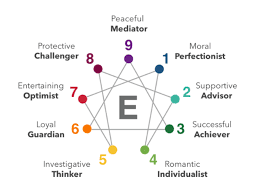This semester on Tuesdays we’ve been taking a deep dive into Young Life team dynamics. If you missed the past posts, check them out here:
Creating Healthy Team Cultural Intelligence
Leading Beyond the College Days

For the past year, one of the hot topics of conversation in the Western Christian church has been the Enneagram.
As Ian Morgan Cron says, “The Enneagram doesn’t put you in a box, so much as it tells you about the box you’re already in…and how to get out.”
I was first introduced to the Enneagram a little over a year ago through a podcast by The Liturgists. At first, I wasn’t impressed, but then I started learning more and found it to be an incredibly life-transforming tool.
If you’re unfamiliar with the Enneagram, it’s an ancient personality test divided into nine types. Unlike other personality identification systems, the Enneagram is not so much interested in telling you what you are as it is in telling you why you do the things you do.
Here are the nine types:
1 – The Perfectionist
2 – The Helper
3 – The Achiever
4 – The Individualist
5 – The Observer
6 – The Loyalist
7 – The Enthusiast
8 – The Challenger
9 – The Peacemaker
The Enneagram is much more complex than the nine types. If you start learning about it you’ll hear words like “wings, subtypes, triads, and where you go in health and stress.” It’s much deeper than just telling you what your type is and then moving on. And while I would love to talk about the Enneagram exhaustively, that’s not what this post is for. Yes, the Enneagram is an interesting conversation to have and it can be really fun to find out what types your friends are, but the Enneagram is meant to be a tool to help you discover why you do the things you do and why others do the things that they do.
If you’re a Young Life leader, you’re likely on a team with people with different personalities, different Enneagram numbers, different interests, different triggers to make them happy or upset, different ideas, different motivations, and different gifts.
Cron explains that the Enneagram is a “low-resolution” picture of people. If you’re a Type 1, The Perfectionist, that does not mean that every single thing about the “1” is going to be true of who you are, but, understanding the Enneagram and discovering why you do what you do and why your co-leaders do what they do can be an incredibly helpful tool for leading together.

I type as a 5, “The Observer,” and I am on a team with a 2, 6, and 9. I love studying and learning. This is what makes 5’s tick. I know my team pretty well, but I’ve learned a lot about my team by studying their types and trying to better understand why they do what they do. Again, these numbers aren’t picture-perfect representations of the people on my team, but I want to know the people on my team better- and as a result, love them better.
When I know that my friend and teammate, Clay, identifies as a type 2, it helps me better understand how to love and encourage him. It also helps me extend grace when I understand his weaknesses, just as I long for him to show me that same patience when he understands my sin patterns.
My encouragement is this- use the Enneagram as a tool to better understand your teammates. In addition to being a lot of fun, it might just help you all work better together and model for the kids a picture of the family of God.
Helpful resources




